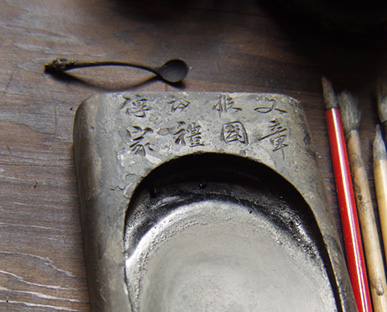Personal ethics and aesthetics
Self-cultivation and tactile expression
One’s body is an instrument and pathway for becoming a particular kind of person; even on the narrow confine of a tabletop self-realization can be played out.
Successive gestures employ objects, and at a more basic level provide a range of sensations. This allows for a variation of surfaces that are cold or warm, rough or smooth. One lifts objects that are dense or light. Some things that old, others new; many have cultural associations. This is the moment for elaborating personal orientation, mood and desires. The depth and importance of sensations comes in part from their quality of being both intimate and ‘just below consciousness,’ acting with and on the individual’s basic nature.
Contrast two means of adding water to a drying inkstone. On the left, a Song (960-1279) water-dropper. Collected and used in later times, it was impressive for its great age, but also for its sensitive handcrafting. The clay is turned and squeezed with a light touch. The glaze is gentle on both eye and hand, and appears to be neither overly thick nor meagrely thin. Despite being in ceramic it seems plump and subtly warm in appearance. To use it, one must take it fully in the fist and invert it gently. It is a work of anonymous folk art where a rhythm of elegance had become second nature among artisans.
Compare this to a nearly modern metal ladle. This is used by precisely pinching it between thumb and forefinger, raising and turning it. It is a delicate operation but also brittle and cold.
Such gestures as these are themselves minor matters. But in combination with many others they fill out a day’s movements, and cumulatively realize distinct ways of living in the world.
 |  |
| Ceramic water dropper Song period (960-1279) Private collection | Inkstone and water ladle 20th century Collection of YU Peng |